

Humberside Geologist No.
12
Reminiscences of some early
collecting in East Yorkshire
by E.V. and C.W. Wright
Preamble.
Over the past few years, my brother (C.W. - "Willy" Wright) has been transferring to the Natural History Museum, South Kensington parts of the collections which we began to accumulate together from the late 1920s. He has now completed the process and all are established in London - .vhere they will be less easy to access! During the summer of 1996 1 have taken a last opportunity of borrowing a few, mainly East Yorkshire treasures in order to photograph them and to refresh memories of the excitement of their discovery and satisfaction in their preparation or reconstruction. In sharing these with fellow members 1 use the plural "we", since my brother and 1 worked together for many years, never argued about who found specimens and often both took a hand in developing a fossil, sometimes over several years.
E.V.W.
As boys in 1929 we were first introduced by Tom Sheppard to the coastal beds from the Speeton Clay to the upper Chalk of Danes Dyke and Sewerby and with him made several expeditions to the East Yorkshire coast by train or bus. Once we could find our own way about, our mother, Mrs Catherine Wright, used to drive us out by car on day trips until we were old enough to have transport of our own. After the usual. picnic, she would join the search and present her finds with the question "Is this anything?", generally expecting rejection onto the beach. But on one occasion in 1931 her find, presented with the customary query "Is this anything?", was a slightly crushed but nearly complete Cidarid sea urchin which she had managed to extract from the cliff with an old spoon which she had picked up on the beach. It was a magnifcent fossil (Plate 1, no. 1) and we duly sent it to the B.M. (Natural History) for identification and they called it Stereocidaris aff. merceyi. A.B. Smith and C.W. Wright have now described it in their current monograph on the Cretaceous Echinoids (Smith and Wright 1989) as a new species closely related to Phalacrocidari. merceyi, the so far unique holotype of P. catherinae, named after our mother who had found it.
Two years earlier however we had made another spectacular find at the same place, the greater part of an articulated starfish. Tom Sheppard was the first to recognise the rows of seeming teeth as the marginal ossicles of a starfish and sent it up to W.K. Spencer of Ipswich, the then authority on the subject, for identification. The fossil then had a somewhat chequered history. Spencer (1931) returned it with the identification as Metopaster parkinsoni and ended his letter with the recommendation that it "ought to be preserved in a museum". Whether the last sentence was an addition by Sheppard was uncertain; but we boys proudly gave it to the Hull Museum in exchange for a plaster-cast. It remained in Hull until 1939 when, realising that we had by then developed a professional interest in Cretaceous starfish, Sheppard exchanged it for the cast and gave us back the actual fossil. This explains why it escaped the destruction of the museum and so much of its collection by enemy action in 1943. When we got the specimen back we found that it was slightly yellowed from the vaseline used when the cast was taken and it has not been possible to remove this entirely although some further development of the middle of the disc has improved its appearance (Plate 1, nos. 2a & 2b). The finding of this fossil was the foundation for a long and fruitful interest in the Asteroids.
Anyone who collects fossils, even from the gently deposited ooze which became the chalk, will recognise that conditions vary for the preservation of relatively heavy hard parts as the joining tissues decay, especially among the Echinoderms. Only rarely is deposition of the matrix swift and bottom conditions thereafter sufficiently undisturbed for Asteroid, Crinoid and many regular Echinoid bodies to remain as unities; the heavier the plates or the weaker the bonding the less likely are they to survive intact. As far as starfishes are concerned we have two examples of the relatively common Crateraster quinqueloba from Flamborough, one from the Hagenowia Zone between South Landing and High Stacks (Plate 1, no. 3) somewhat crumpled and another (Plate 1, no. 4) from the Uintacrinus chalk east of Danes Dyke which is undistorted, nearly complete and of which we were able to clean the underside to display the small middle plates. We had extracted what we thought was all there was of the latter from the cliff, but on cleaning found that the fossil continued back into the chalk. So the next day we returned, found the marks in the cliff and extracted all that was left, with the satisfying result you see. This specimen represented something of a high point in exposing and cleaning fossils in the extremely hard Flamborough chalk. Hand and eye were more precise in those days than now in our old age!
We turn next to describe a single memorable excursion, one of our first to the relatively barren stretch of cliff between High Stacks and South Landing. The Hagenowia chalk there is even harder than normal for Yorkshire, but was then very clean and air-weathered, so that even the smallest fossils were visible. We had recently read the paper by A.W. Rowe, the Thanet medical practitioner and amateur stratigrapher of the English Chalk on the Chalk of Yorkshire (Rowe, 1904) and reckoned that anything he could find so could we! He had recorded Ophiuroidea ("feather-stars") and the tiny, regular sea urchin, Zeuglopleurus rowei, from the Flamborough sections and we eventually found three specimens of the latter there. We also obtained a copy of H.T. Withers Catalogue of British Cretaceous Cirripedia (barnacles) (1935) and had the very distinct, component plates of those in our mind's eye too. On that one excursion to High Stacks we found two specimens of different species of Ophiuroid, the more complete of which (Ophiura substriata) is shown in Plate 1, no. 5; and a nice carina of the cirripede Cretiscalpellum maximum, a first for us from Yorkshire. Another unexpected find was the somewhat jumbled remains of a very small starfish which we think is the long-armed Ophryaster magniis (Plate1, no. 6). This experience underlined two lessons which were brought home to us over the years. The first is that even comparatively barren deposits can yield surprising results if collecting conditions are good. The second is that study of a particular group of fossils often results in their recognition even when only a small part of the animal is exposed. Both were significant factors on that unpromising excursion to High Stacks and made it one of our more fruitful trips.
There is no disguising our long-lasting interest in echinoderrns and especially asteroids; but it is hard to overlook the free-swimming crinoids which are such a common feature in the Yorkshire Chalk. For all their abundance, it is rare for the collector to find the earlier of the two, Uintacrinus, as anything but loose plates from the sac or segments from the long tentacles. Very occasionally some of the plates are found joined together or short lengths of arm (Plate 1, no. 7 a & b); but there is nothing to compare with the wonderfully complete examples from the U.S.A. to be seen in museum collections. R.M. Stainforth of our Society did however find in one of the inland pits about one third of an undistorted sac which he later presented to Imperial College, University of London. The relative weight of the plates and weakness of connecting tissue no doubt contribute to the scarcity of even partially complete specimens in this country.
At Flamborough to the west of Danes Dyke, however, the stratigraphically higher free-swimming crinoid, Marsupites testudinarius, can be found quite commonly with the bag-like sac complete or nearly so. It is another matter entirely to extract them because the plates are heavily omamented on the outside and tend to come away with the outer matrix (Plate 1, no. 8).
In the collection, however, is one beautifully preserved sac of M. testuditiarius which is quite undistorted (Plate 2, no. 1 a & 1 b) and includes the cover-plates of the opening. It is also interesting for a single, anomalous, extra plate protruding from the otherwise symmetrical base. This was found at Beverley by D.W. Toyne, an assiduous collector and member of the H.G.S. He was of the Hull seedsman family and his fossils came our way in the late 1930's from R.M. Stainforth to whom they had passed when Toyne was killed in a rnotor-cycling accident. The examples from inland are generally much less heavily ornamented than the coastal specimens.
Try as we would, we were never able to find in Yorkshire any of the third group of free-swimming crinoids, the minute Roveacrinidae, although we did obtain them from air-weathered surfaces in the Isle of Wight.
When it comes to the Cretaceous asteroids, it was the pioneering work of W.E. Spencer himself which made their identification a relatively simple exercise (Spencer 1913). Spencer was an Inspector of Schools and amateur palaeontologist who became the world authority on fossil starfish. He recognised that in the majority of genera of Pentagonasteridae the marginal ossicles, which form a substantial border surrounding the pentagonal, central area are generically and specifically distinct. As these ossicles are more usually found in our Cretaceous deposits separated from each other, he developed a simple and reliable method of identifying them even in the field. In the 1930's we were able to find and identify most of Spencer's species up and down the country, nearly all from separated marginal ossicles. In addition to the four articulated specimens from the Flamborough chalk mentioned above, we had a number of other articulated fragments from southern counties.
The Danes Dyke - Sewerby section did, however, yield two specimens which provided an opportunity for some original work, one with dramatic results. Each was found as a jumbled mass of ossicles plainly of a single individual and we decided that a more informative "specimen" would emerge if they were separated from their matrix and reassembled in their correct places. By this time we could recognise with confidence from the articular surfaces which plate fitted next to which and into part of the arc or arm. The first attempt was made with the simple "jigsaw-puzzle" represented by a piece of Metopater uncatus of which little more than one side was present (Plate 2, no. 2); but it was useful practice. The second, similar jumble was much more extensive than the first and more difficult. It is a usual characteristic in the genus Metopaster to which this seemed to belong that the several terminal inferomarginals, up to five in number at the points of the star, are matched in the superomarginal series by single "fused" ossicles as can be seen in Plate 2, no. 2 or the side view of the M. parkinsoni in Plate 1, nos. 2b. The supero- and infero-marginalia can easily be distinguished from each other by their profiles. When we came to separate and clean the Sewerby specimen we were surprised to find that there were no "fused", terminal supero-marginals but separate, matching ossicles of decreasing size in both the upper and lower rows. We could tell from the articular surfaces how many median marginals there had been in each of the five sides. From the original jumble there eventually emerged the shape of a nearly complete starfish, not only with the "unfused" supero-marginals at the corners, but also with these appearing to be permanently upturned so that they were more than twice the height of the rest of the disc. We named the Sewerby specimen (Wright and Wright 1940) after Robert Stainforth who had found a fragmentary, articulated example which supported our reconstruction. At the time we placed the new species in Metopaster; but a few years after, Brunnich Nielsen (1943) described a new genus, Recurvaster, for later Danish specimens also with the characteristic upturned arms and our species should be referred to that genus of which much fine material is now known from the Continent (Rasmussen 1950; Schulz & Weitschat 1975), again fully confirming the soundness of our reconstruction of the Sewerby specimen (Plate 2, no. 3 a & 3 b).
We conclude this article, describing activities going back fifty or sixty years, by recalling the ultimate outcome of our "starfish-building" and, after a detour in Norfolk, finally return to East Yorkshire. In 1938 we went on holiday to Sheringharn in North Norfolk and had some good finds in the B. mucronata chalk of that area. To our disappointment, articulated specimens of starfish proved very scarce although detached ossicles were abundant. However, we did find two separate, jumbled conglomerations of mixed echinoderm plates - one at Weybourne and the other from a small beach-exposure at West Runton. These we interpreted as the disgorged, hard parts of the food-prey of some predator which had ejected the indigestible matter after the manner of some owl-pellets, hence their description in our register as "Pellet 1" and "Pellet 2" respectively. One contained ossicles of nine species of asteroids, the other eleven.
In Pellet 1 there were sufficient marginal ossicles apparently of one individual to make up about half of the margin of a very curious starfish, in particular having very obvious pairs of unusually bulbous supero-marginals. Reconstruction of the collapsed remains of starfish had by then become almost second nature and our first attempt at rebuilding had placed these pairs in the middle of each side. We were confident enough to prepare it for publication as the holotype of a new species of the genus Chomataster. However, as it happened, in the previous year we had found in the B. mucronata chalk at Studland in Dorset a small piece of an articulated specimen identified as the already known Chomataster precursor (Spencer, 1913) and study of this convinced us that the paired ossicles should properly be located at the base of each narrow arm radiating out from a typical, pentagonal central disc. The first reconstruction of the Norfolk specimen was dismantled and the ossicles reassembled according to the new scheme which made much better sense, producing a satisfactory fit of all three groups of the apparently related plates: in the supero-marginal case, with four median ones on each side of the body; then the bulbous ones back-to-back at the corners; and finally some unusual shaped ones to form long, pointed arms. There were nearly as many infero- as supero-marginals present and altogether they made up into a most convincing, albeit novel creature (Plate 2, no. 4). At least one of the ossicles had a piece of echinoderm shell welded into its surface which lent support to the theory that the animal had been swallowed, partly digested and the indigestible residue then disgorged (Wright & Wright, 1940). The validity of the hypothetical reconstruction was again recognised, as with the R. stainforthi, when a well preserved, articulated specimen of precisely similar characteristics was found in the Campanian chalk of Lagerdorf in N. W. Germany. The Gertnan example has been published (Schultz & Weistchat, 1975) as the holotype of Chomataster alseni and that from Norfolk is almost certainly of the same species.
The final episode in the story of "Starfish-building" concerns an amorphous mass of very small starfish ossicles from the Turonian chalk at Hessle which we had found in 1939 and tentatively ascribed to the genus Valettaster known from the south of England. One of us was not satisfied with this identification and, having the time and in those days manual dexterity, removed all the ossicles from the matrix which was hard even by Yorkshire standards. They ranged in size from about 2 to 4 millimetres in breadth and when cleaned turned out to be the remains of several individuals; of two species of Metopaster and three marginals of a Craterasterquinqueloba. Clearly we had another "pellet" on our hands! A number of the ossicles identifiable as M. parkinyoni were plainly of one individual and there were enough to make up a nice little starfish about 17mm along one side of the pentagon (Plate 2, no. 5). The rest of the Metopaster ossicles were typical of Muncatus and judging by their size probably from three individuals. Unfortunately there were not enough of each to restore the originals with as much confidence as in the case of the M. parkinsoni, but they could be mounted in the correct order of upper and lower rows (Plate 2, no. 6). The three Crateraster plates, two supero- and one infero-marginal, were too few for an attempt at reconstruction.
It is interesting to speculate on the nature of the predator which might have fed on a diet of echinoderms, predominately starfish. They are presumably dredged up from the ooze of the seabed and one candidate might have been a fish such as Ptychodus whose grinding teeth are not uncommon in the Turonian of East Yorkshire and North Lincolnshire. Another and perhaps stronger possibility might have been a larger starfish such. as a Pycinaster or, in the Norfolk case, a Teichaster of which we had an articulated piece of large size from Trimingham. One can imagine such a creature ploughing its way along the bottom and eating any living thing in its path as the giant Pycnodia does today off the coast of Oregon.
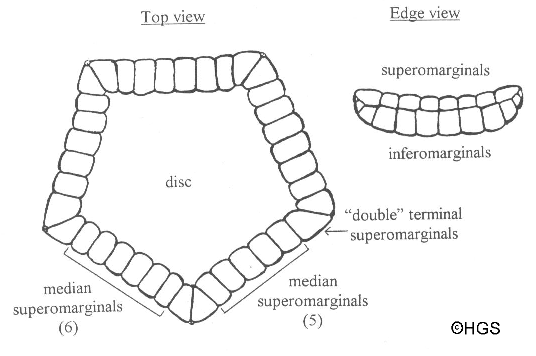
Diagrammatic representation of typical Pentagonasteroid starfish (Metopaster)
Plate 1
Phalacrodcidaris catherinae Smith and Wright, Holotype
I. Lingua Zone, Lower Campanian, Danes' Dyke West
(2) Metopaster parkinsoni (Forbes)
I. Lingula Zone, Lower Campagnian, Danes' Dyke West

(3) Crateraster quinqueloba (Goldfuss)
M. coranguinum Zone, Upper Coniacian or Lower Santonian, Danes' Dyke West
Upper side,
enlarged.
4. Crateraster quinqueloba (Goldfuss)
Marsupites Zone, Upper Santonian, Danes' Dyke East
(5)
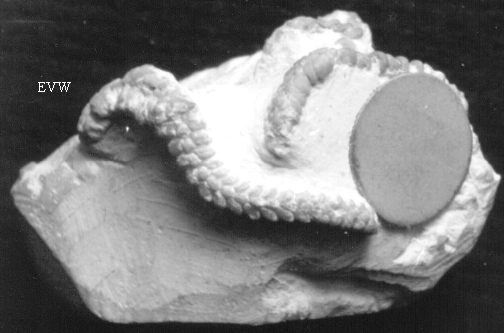
Opiura Substriata (Rasmussen)
M. Coranguinum Zone, Upper Coniacian or Lower Santonian. High Stacks, x2
(6)
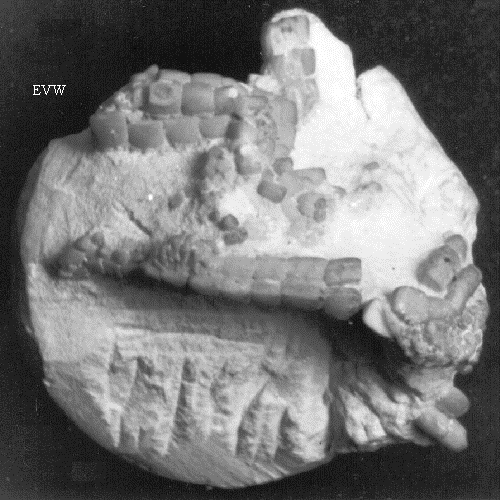
?Ophryaster magnus (Spencer)
M. Coranguinum Zone, Upper Coniacian or Lower Santonian. High Stacks, x2
(7)

Uintacrinus socialis (Grinnel)
Uintacrinus Zone, Upper Santonian, Danes' Dyke East
Articulated
Fragments, (a) Base of arms (b) sac, enlarged
8. 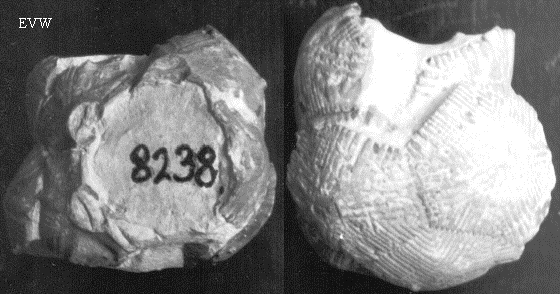
Marsupites testudinarius (Schlotheim)
Marsupites Zone, Upper Santonian, Danes' Dyke West
Typical ornate examples, (a) Top of sac with sockets for arms (b) Side view
Plate 2
(1) Marsupites testudinarius
(Schlotheim)
Marsupites Zone, Upper
Santonian, Beverley
Undistorted sac (D.W. Toyne collection)
 (
(
(b) Base
Note: anomalous plate in base of sac
(2)
Metopaster uncatus (Forbes)
I Lingula
Zone, Lower Campanian, Danes' Dyke - Sewerby
Reconstruction of a crumpled
fragment
(3) Recurvaster stainforthi (Wright and Wright) Holotype
I
Lingula Zone, Lower Campanian, Danes' Dyke - Sewerby
Reconstruction of
jumbled remains.
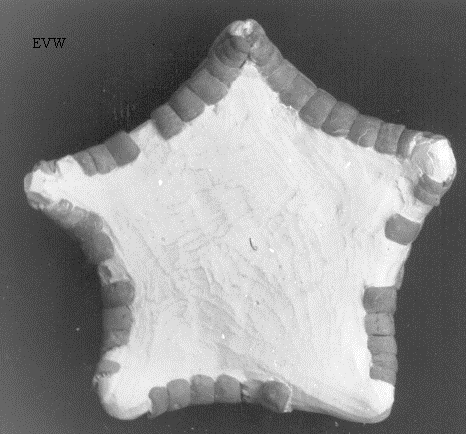
(b) Side, enlarged. Note upturned corners
(4)
Chomaster alensi (Shultz and Weischat)
B.
Mucronata Zone, Upper Campanian, Weyborne, Norfolk.
Reconstruction of
ossicles from "Pellet 1"
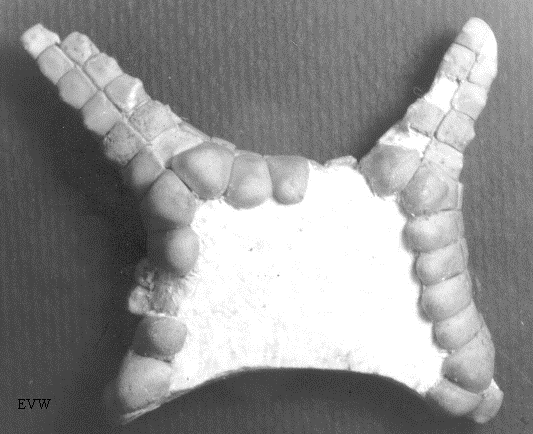
Metopaster
parkinsoni (Forbes)
T. lata Zone, Middle Turonian, Hessle
Reconstruction of ossicles from "Pellet 3"
Ossicles
of Metopaster uncatus
(Forbes) and Crateraster
quinqueloba (Goldfuss)
T. lata Zone, Middle Turonian, Hessle
In
probable relative positions, "Pellet 3"
References
Nielsen, K.B., 1943. The Asteroids of the Senonian and Danian Deposits of
Demnark. Det Kongelige Danskt, Videnskaberties Selskab. Biologiske Skrifter
11, 5: 68 pp, 4 pls.
Rasmussen, H.W., 1950. Cretaceous Asteroidea and
Ophiuroidea with special reference to the Species found in Denmark.
Danmarks
Geologiske Undersogelse II, 77: 134 pp, 18 pls.
Rowe, A.W. 1904. The
Zones of the White Chalk of the English Coast IV - Yorkshire.
Proceedings of
the Geological Association 1.8:
193-296 pls 17-40.
Schultz, M.G.
and Weitschat, W., 1975. Phylogenie und Stratigraphie der Asteroidea der
Nordivestdeutschen Schreibkreide Teil 1: Metopaster / Recurvaster - und
Calliderrna / Chomataster - Gruppe. Milteilungen aus dem Geologisch -
Palaeopitologisclien Institut der UniversitatHamburg,
44: 249-2 84,
pls 24-3 1.
Smith, A.B. and Wright, C.W., 1989. British Cretaceous
Echinoids. Part 1 General Introduction and Cidaroida.
Monograph of the
Palaeontographical Society of London: 1.-101, pls 1- 32.
(Publ. No. 578,
part of Vol. 141 for 1987).
Spencer, W.K. 1913. The Evolution of the
Cretaceous Asteroldea. Philosophical Transactions of the Royal Society of
London - Series B,
204 99-107, pls 10-16.
Spencer, W.K. 1931. A
Rare Yorkshire Fossil Starfish. Naturalist,
No. 890: 80, text fig.
Withers, T.H. 1935.Catalogue of the Fossil Cirripedia in the Department
of Geology Vol 11. Cretaceous.
Pp 433 pls 50. British Museum (Natural
History).
Wright, C.W. and Wright E.V. 1940. Notes on Cretaceous Asteroidea.
Quarterly Journal of the Geological Society of London,
96:
231-248, pls 13-17.
Return to Humberside Geologist
Copyright Ó Hull Geological Society, 1999
Registered Educational Charity No. 229147